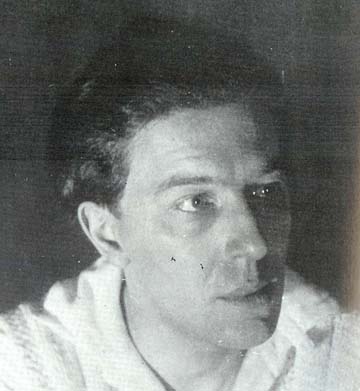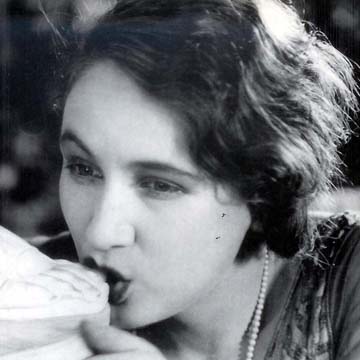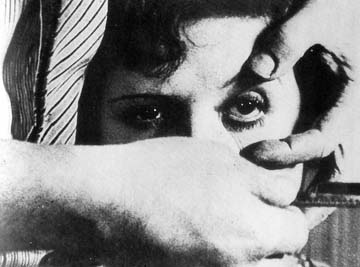Surrealism's Revisionist Reading of Freudian Psychology: Surreal Film and the Dream
5 Sep 2009
Surrealism is based on the notion of a superior state of consciousness, an absolute reality, or Surreality, which manifests as the modes of the dream (unconscious) and reality (consciousness) are brought together momentarily within an ongoing, ever-renewed dialectic. As Andre Breton states in the Manifestoes of Surrealism, it is the cinema, according to the surrealists, that will lead to the "future resolution of these two states, dream and reality, which are seemingly so contradictory." The momentary synthesis, or aggregate, of these realms produces a higher state of perceptual awareness (intuition), which facilitates an understanding of reality that is beyond the means of rational or discursive logic. The Surreal mode of aesthetic cognition, or perception, is comparable to the phenomenon that the spectator undergoes during an aesthetic experience when encountering an object of art. In this enraptured and altered state of mind, the consciousness is released from the demands of attending to life-concerns that are either practical or theoretical in nature by the effect of the free and spontaneous essence of the artwork.

For the Surrealists, the aesthetic experience represents a legitimate "noetic" moment of authentic metaphysical insight into the grounds of reality. It is a moment of perceptual and cognitive enlightenment, which can be understood in terms of what William James has written in Varieties of Religious Experiences about mystical states of consciousness, which are described by James as "states of insight into depths of truth unplumbed by the discursive intellect. They are illuminations, revelations, full of significance and importance, all inarticulate though they remain; and as a rule they carry with them a curious sense of authority for after time."
The Surrealism of Breton, as we understand it today, would not exist without Freud's monumental work, for Surrealism adopts Freud's basic model of human psychology and the notion that base drives unconsciously contribute to the formation of the individual's personality. As Ruth Brandon recounts in Surreal Lives, "Breton had realized that here, in Freud's writings, lay the route-map from the great artistic journey of the coming century: the journey to the interior." Breton was first exposed to Freud through references and short excerpts of his work in translation, which appeared in the seminal French texts, Precis de Psychiatrie by Dr. Regis and La Psychanalyse by Regis and Hesnard. Breton's notion of automatic poetry was partially inspired by these initial encounters with Freud's writings.
Breton had great hopes for the aesthetic application of Freud's theories, and in 1921 Breton visited Vienna, where he met and conversed with Freud. However, Breton was greatly disappointed because Freud was detached, he engaged Breton in the most banal manner. The conversation consisted, on Freud's end, of trite pleasantries and vague generalities. In 1932, Breton once again contacted Freud, this time through letters Breton sent Freud several examples of dreams that Breton himself had analyzed. In a way, Breton was hoping for Freud's approval, not only with respect to the attempted dream analyses, but also with respect to the entire Surrealist movement. A response eventually came, but again Breton was disappointed, the communication was terse and somewhat apologetic, in that Freud admitted, to his dismay, that he did not understand Surrealism. "Although I have received many testimonies of the interest that you and your friends show in my research," wrote Freud, "I am not able to clarify for myself what surrealism is and what it wants [...] perhaps I am not destined to understand it, I who am so distant from art."

Since this essay is concerned with exploring the relationship between Freudian psychoanalysis and Surrealist film, I begin by explaining their respective views on the human psyche, which differ on critical points of interpretation. Freud's quest to unlock the secrets of the unconscious workings of the mind, attempting to establish a legitimate science of behavior and personality, is founded on the therapeutic goal of helping humans exist efficiently and productively as viable members of society. According to Freud, the purpose of an organized society is threefold: (1) to protect the human from nature's onslaughts; (2) to help control the human's self-destructive instincts; and (3) to create conditions that enable humans to pursue ecumenical goals and ideals. Freud believed that the potential for a thriving society begins with the harmonious integration and organization of the three psychic systems.
In Civilization and Its Discontents, Freud admits that socialization places great demands on the human, and the level of self-control required to ensure productive societal relationships can have detrimental effects on individuals, such as inducing depression and feelings of anxiety. For the most part, society is built on what Freud calls "the renunciation of the instinct," i.e., when the personality is stabilized and the powerful instincts are transformed through "habitual displacement, sublimation, and compromise" into nonaggressive or nondestructive forms of behavior. This occurs as a deflection of energy into higher-level intellectual endeavors, and Freud claims these features of psychic management are necessary for the "encouragement of man's higher mental activities, his intellectual, scientific, and aesthetic achievements." It must be noted that none of these activities is possible without the necessary imposition of rules, which demand the transformation or suppression of certain drives. Interestingly, in his later work, Freud states that it is not the sexual mechanism that poses the greatest threat to human society, but rather the main conflict between the individual and society results from the unchecked "instincts of aggressiveness and self-destructiveness." The reason is that the sexual urges (libido) can be controlled to a greater degree, which is to say, that most sexual desires can be satisfied within the bounds of socially accepted behavior.

Freud links the discussion of the libido, human aggressiveness, and self-destructive behavior (e.g. the death drive) directly to the id. Accordingly, the drives that comprise the id are antithetical to the processes of logical reasoning, as it operates according to the pleasure principle. In the case of the id, its functioning takes into account neither social rules nor the practical consequences of human action. A productive societal existence would be impossible if the id directed human behavior, and for this reason, socialization requires that the id be controlled. This occurs through a variety of repressive techniques, which in great part, allows for the redirection of the id into acceptable activities. However, as Freud is careful to point out, the ego does not exercise absolute control over the id, and, as he states, "even in normal people, the id cannot be completely controlled beyond certain limits." To control the id's functions, attending to the processes involved in successful socialization, Freud advocates education and training of the rational faculties, which requires, of course, the invaluable assistance of the therapeutic science of psychoanalysis, or "the talking cure."
It is necessary, when discussing the Surrealists' appropriation of Freud to stress at the outset that this move simultaneously entails the rejection of certain Freudian tenets, however, the Surrealists do not reject Freud outright, instead they reinterpret his findings, reexamine his work through the lens of philosophy, so to speak, for they are concerned, beyond science, psychology, and materialism with such thoroughgoing philosophical questions as, "What is real as such?" "What is the nature of knowledge, and how is it verified?" And, finally, "What is properly moral with respect to the human and society?" Breton is clear, as he writes in Manifestoes of Surrealism, that Surrealism is out to "solve the problems of the world" through aesthetic-philosophical means, and this project entails analyzing, assessing, and ultimately, the attempt to correct the negative influence of Freudian psychology on Western Europe, most particularly the effect of domestication that Freud's science has on the creative, autonomous intellectual (aesthete) of modernity.
It is possible to argue that the Surrealists in fact misappropriate Freud, and in specific ways, misinterpret and misrepresent his objective therapeutic science in terms of a system of values arising from their own misinformed agenda. In The Rebel, Camus argues that the Surrealists' "metaphysical rebellion," embodying a strange hybrid of aesthetics, asceticism, mysticism, and Marxism, led to the eventual demise of the movement, which was originally conceived by Breton as an aesthetic revolution for overturning modern political and social values. Camus claims that in the 1930s, when the Surrealists chose sides, between politics and poetics, Breton opted for the latter, and with his move away from Marx and toward Rimbaud, a position that favored mysticism and asceticism over committed activity, Breton drifted from the stance adopted in his first manifestos, wherein claims to change the world rang loudly, and, in doing so, Breton "demonstrated that Surrealism was not concerned with action, but with ascetic and spiritual experience," at a remove from the realm of practical activity.

In The Interpretation of Dreams, Freud locates the content of the unconscious, "the psychologically significant source of the dream," in the material world and the events that comprise everyday existence. The mysterious activity of the libido inspires the unconscious, and this repository of latent desires, tensions, and unsolved problems recoil on the dreamer as she sleeps. As stated, Freud defines the instincts as having biological aims, sources, and objects, which manifest through the process of psychoanalyzing the patient. According to Freud, the content of the unconscious is explainable scientifically. It is clearly with confidence that Freud states that through the implementation of his psychological techniques, "[E]very dream will reveal itself as a psychic structure, full of significance, and on that may be assigned a specific place in psychological activities of the waking state." Since the patient's repressed desires are expressed symbolically in dreams, to have a greater understanding of the dream is at once to gain insight into the inner workings of the patient's psyche, hence pointing a way toward a legitimate cure for her neurotic predispositions. However, unlike Freud, the Surrealists do not seek to quell, control, or "cure" the tumultuous agitated activity of the unconscious, for they believe that such a task as Freud conceived it is impossible. Rather, they look to the unconscious in order to unlock the secrets of the material world, viewing unconscious activity, and, what is most important, the general functioning of the id, as representing the interface between the authentic metaphysical grounds of materiality and the human's waking existence.
To reiterate, as opposed to understanding reality through empirical investigation, which includes the science of psychology, they sought access to the mysteries of existence through aesthetic-philosophical activity, which manifested a moment of spiritual enlightenment. According to Ferdinand Alquie, in The Philosophy of Surrealism, the Surrealists sought to explain the physical world by plumbing its depths, by attempting to "penetrate into what has more reality than the logical and objective universe." For the Surrealists, this ultimate reality resided behind the veil of surface appearances, and was linked intimately with the world of the dream. According to the Surrealists, when dreaming, the sublime essence of life speaks by way of the soul's agitation, through the appearance of obsessive, instinctual feelings and desires. As the world's life-force manifests, the imagination and memory form significant representations, or artful simulacra in motion. For the Surrealists, the dream contains meaningful symbolic representations, and its analogical method of communicating knowledge through association as opposed to cause and effect (logic) is best approximated within the aesthetics of film.
Initially Breton thought "nonsense" poetry held the potential to reach the heightened state of Surreality. Reading poetry created by means of random chance was thought to relax the rational faculties and cause the rigid barrier between conscious and unconscious states to dissolve. However, as Jean Goudal reasons in his 1925 article, "Surrealism and Cinema," Breton's theory is flawed because he begins from an erroneous notion of language. Since all forms of written and verbal communication operate within the logical rules of grammar, it is therefore impossible to access a primordial realm of pre-linguistic thought by way of poetry, no matter how bizarre or creative it is, for as Goudal writes, "The complete repudiation of logic is always forbidden to language." Since we rely on the logical structure of grammar to understand it, the nonsense poetry of Breton degenerates into an incomprehensible babble. This is not so, according to Goudal, with the medium of film.
Cinematic images hold the potential to bypass the logical grounds of language and to achieve what Breton's poetry could not. Due to the rapidity of the film's images, the logical mechanism--which tries to explain the images through memory--does not have time to be engaged. Cinematic meaning occurs in an altogether different manner from that of the literary domain. In the cinema, the mind is working to connect images. As opposed to forming representations of what is observed, a process grounded in language, cinematic ideas are formed through association. The power and immediacy of cinematic imagery thrusts the force of its communication beyond the purely logical or discursive functioning of reason, and so film reproduces characteristics of the dream. Thus, the Surrealists embrace the cinema's potential for channeling the omnipotent and authentic dreamlike mysteries of life. It is ultimately film that engenders the Surreal experience that Breton first describes in Manifestoes of Surrealism, wherein he claims that this enlightened state, the encounter with a "superior reality," manifests the authentic grounds of the physical world. In this moment of truth's awakening, the mind does not consciously or actively grasp the "resolution of the two states of dream and reality;" rather, through the experience of film, which facilitates their communion, the role of human reason is "limited to taking note of, and appreciating, the luminous phenomenon."

Works Cited:
1. Alquie, Ferdinand, The Philosophy of Surrealism, trans., Bernard Waldrop, (University of Michigan: Ann Arbor, 1967).
2. Brandon, Ruth, Surreal Lives: The Surrealists 1917-1945, (Grove Press: New York, 1999).
3. Breton, Andre, Manifestoes of Surrealism, trans., Richard Seaver and Helen R. Lane, (University of Michigan: Ann Arbor, 1972).
4. Camus, Albert, The Rebel,/i>, trans. Anthony Bower, (Vintage: New York, 1991).
5. Freud, Sigmund, Civilization and Its Discontents, (Hogarth Press: London, 1930).
6. ______, The Interpretation of Dreams, (Hogarth Press: London, 1953).
7. Goudal, Jean, "Surrealism and Cinema," from The Shadow and Its Shadow, trans. and ed., Paul Hammond, (City Lights Books: San Francisco, 2000).
8. James, William, Varieties of Religious Experiences, (Longmans, Green, and Co.: New York, 1923).
◊